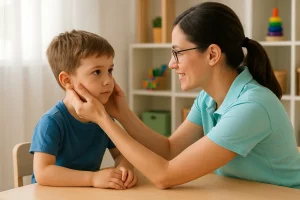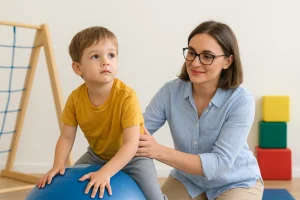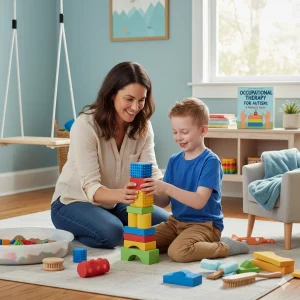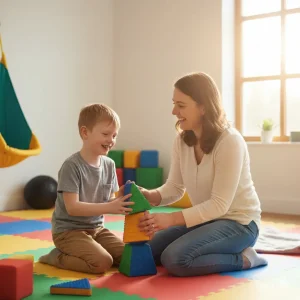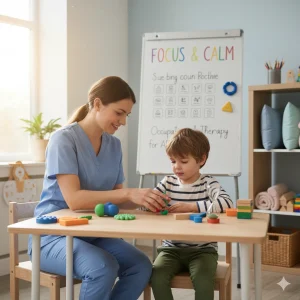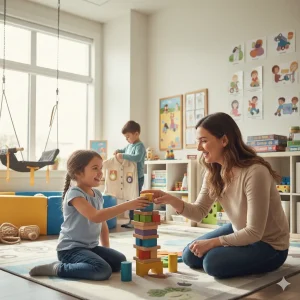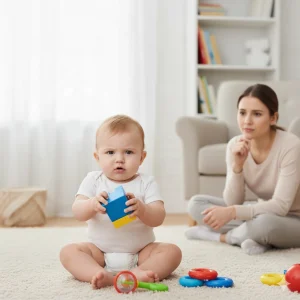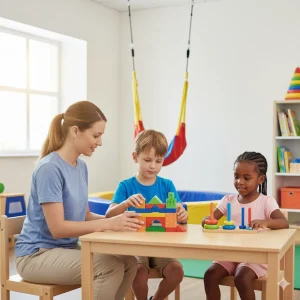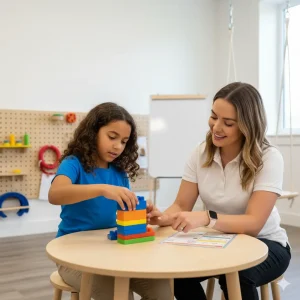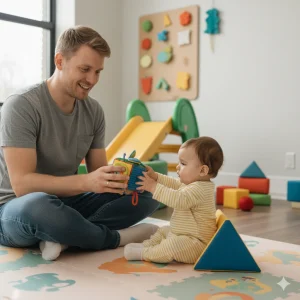Is Your 1-Year-Old Delayed? Occupational Therapy for 1-Year-Old
By Wellness Hub
Last Updated: October 8, 2025
Worried your 1-year-old might be delayed? it’s important to recognize the early signs of a 1-year-old developmental delay and understand how simple, play-based strategies can make a big difference. At 12 months, babies are building the foundation for walking, talking, and social interaction—but when milestones like waving, pointing, or grasping small objects don’t appear on time, parents often look to professionals for guidance.
This is where occupational therapy activities for 1-year-olds come in. These early interventions focus on strengthening fine motor, gross motor, and sensory skills through everyday play. By learning these strategies, you’ll not only gain practical knowledge for your coursework but also be better prepared to support children and families in real-life settings. Early exposure to home OT activities and developmental milestone tracking helps bridge the gap between theory and practice—equipping you to identify red flags and recommend appropriate next steps.
What Are the Normal 12-Month Developmental Milestones?
By the time your baby turns one, you’ve probably noticed huge changes in their abilities — from crawling across the room to babbling sounds that almost feel like words. These are called 12-month developmental milestones, and they mark important steps in your child’s growth. While every baby develops at their own pace, most 1-year-olds begin to show progress in gross motor skills, fine motor skills, and social milestones around this stage.
Gross Motor Skills (Big Movements)
At 12 months, many babies are learning to control their larger muscles. You may notice your child:
- Cruising (walking while holding onto furniture for support)
- Pulling to stand and trying to balance with little help
- Taking a few unsteady steps or walking with assistance
These gross motor activities for a 12-month-old build strength, coordination, and confidence as your baby works toward independent walking.
Fine Motor Skills (Small Movements)
Fine motor skills are about the smaller muscles in the hands and fingers. Around one year, your child may:
- Develop the pincer grasp (picking up small items like cereal using thumb and finger)
- Point to objects that catch their interest
- Try to stack blocks or bang toys together
These early fine motor skills in a 1-year-old prepare your child for feeding themselves, playing with toys, and later, holding a crayon or spoon.
Social and Communication Milestones
Social milestones at 12 months are just as important as movement. You may see your baby:
- Waving “bye-bye”
- Responding when you say “no”
- Copying simple actions like clapping
- Using gestures (like pointing) to get your attention
- Showing preference for familiar people
These early communication skills are building blocks for language, relationships, and emotional growth.
Red Flags at 12 Months: When to Pay Attention
It’s natural for babies to reach milestones at slightly different times. But if you notice certain signs, it may be worth talking to your pediatrician or an occupational therapist. Some red flags at 12 months include:
- Baby not pointing at 12 months to objects or people
- Not waving bye-bye at 1 year
- Not walking at 12 months (Some children walk closer to 15–18 months, but lack of attempts to cruise, pull up, or bear weight may signal a delay)
- Little to no response to their name or simple instructions
- Limited interest in interaction or play
Remember: one missed milestone does not always mean a problem. But if several of these signs appear together, early intervention can make a significant difference.
Signs Your Baby May Be Developmentally Delayed
As a parent, it’s natural to wonder: “What if my 1-year-old isn’t walking, waving, or using a pincer grasp?” Every child grows at their own pace, but there are certain 1-year-old developmental red flags that may suggest your baby needs extra support. Recognizing these early can help you make informed decisions and seek professional guidance when needed.
Also read: Early Warning Signs of Developmental Delays in Kids
Motor Development Concerns
- Not walking at 12 months: While it’s common for babies to start walking closer to 15–18 months, by one year most children are at least pulling to stand, cruising along furniture, or trying to balance. If your baby shows little interest in bearing weight on their legs, it may be worth mentioning to your pediatrician.
- Limited use of hands and fingers: By 12 months, many babies use a pincer grasp (thumb and forefinger) to pick up small objects. If your child still relies only on a whole-hand grasp and isn’t trying finer movements, this could signal a baby milestone delay in fine motor development.
Social and Communication Red Flags
- Not waving bye-bye at 1 year: Gestures like waving, clapping, or pointing are important social milestones that show your baby is learning to connect and communicate. A lack of these may be a red flag.
- Not pointing at 12 months: Babies usually point to things they want or find interesting. If your child isn’t pointing or making eye contact when trying to get your attention, it may indicate a delay in communication or social skills.
- Not responding to simple words: By one year, most children will turn when their name is called or pause when they hear “no.” If your baby does not respond consistently, it may be a sign to look more closely at their developmental progress.
Know more about our article on 12 Must-Know Social Skills Every Child Should Learn
Early Signs of Sensory Processing Issues at 1 Year
Some babies show challenges not only in motor or social milestones but also in how they respond to the world around them. Early signs may include:
- Overreacting to sounds, textures, or lights (e.g., crying at normal household noises or avoiding certain foods/clothing)
- Little curiosity to explore toys or surroundings
- Preferring repetitive play without trying new actions
- Difficulty calming down after sensory input (like loud noises or crowded environments)
When to Seek Guidance
Missing one milestone alone doesn’t always mean there’s a serious problem — children grow on slightly different timelines. But if your child is showing multiple developmental red flags at 12 months, it’s best to consult your pediatrician or an occupational therapist. Early intervention can help strengthen motor skills, improve social communication, and support sensory development, giving your baby the best chance to thrive.
Role of Occupational Therapy in Early Development
As a parent, you may wonder how occupational therapy for babies—often called OT for infants—fits into your child’s growth. Occupational therapy is not just for adults recovering from injuries. In fact, for young children, OT focuses on helping them build the foundational skills they need to explore, learn, and interact with the world around them.
What Is Occupational Therapy for Babies?
Occupational therapy for infants is a specialized form of therapy that supports development through play, daily routines, and hands-on activities. An OT evaluation for infants looks at how your child is progressing across different areas—motor skills, sensory processing, coordination, and social engagement. The goal is to identify strengths and gently address any challenges before they interfere with everyday growth and learning.
Why Early Intervention Matters
The first years of life are a critical window for brain and body development. If a 1-year-old developmental delay is suspected, starting early intervention for a 1-year-old can make a remarkable difference. Research shows that the earlier children receive support, the easier it is for them to catch up with peers and gain confidence in their abilities.
Key Benefits of Occupational Therapy for Infants
- Motor Development
- OT activities help babies strengthen both large and small muscles.
- For example, practicing crawling, cruising, or stacking blocks builds gross motor skills and fine motor coordination.
- Sensory Processing
- Some babies struggle with sensory input—becoming easily overwhelmed by sounds, textures, or movement.
- Occupational therapists use gentle sensory activities (like safe sensory bins or play with textured toys) to help babies regulate and enjoy new experiences.
- Hand-Eye Coordination
- Activities like grasping toys, self-feeding, or rolling a ball improve hand-eye coordination, preparing children for later tasks like drawing or dressing themselves.
- Daily Living Skills
- Even at 12 months, OT supports early independence skills: drinking from a cup, self-feeding, imitating gestures, or exploring safely.
- These are the building blocks for routines like eating, dressing, and playing—making everyday life smoother for both baby and parent.
A Partner in Your Child’s Growth
If you’ve noticed concerns such as baby milestone delays, limited pointing, or lack of interest in play, an OT evaluation for infants can provide clarity and guidance. Rather than waiting to “see if they catch up,” occupational therapy empowers parents with practical strategies they can use at home, turning playtime into an opportunity for learning and progress.
Early Occupational Therapy Activities for a 1-Year-Old
When it comes to helping your baby grow, play is more than just fun—it’s the foundation of learning. Early occupational therapy activities for a 1-year-old can be done right at home, using everyday items. These activities support your child’s fine motor skills, gross motor development, sensory processing, and hand-eye coordination. By weaving these exercises into daily playtime, you can boost your baby’s confidence and give them the skills they need for their next milestones.
1. Fine Motor Activities
At 12 months, babies are beginning to refine the small muscles in their hands and fingers. Supporting fine motor development helps them explore, feed themselves, and eventually prepare for skills like drawing or using utensils.
Try these OT activities for fine motor skills:
- Pincer grasp activities for babies: Offer small, safe snacks like cereal puffs so your baby can practice picking them up with thumb and forefinger.
- Stacking cups or blocks: Simple toys encourage grasping, releasing, and problem-solving.
- Shape sorters: These strengthen hand-eye coordination and early problem-solving skills.
- Finger painting: Messy, colorful fun that promotes creativity while working on hand control.
Tip: Repetition is key. The more chances your baby has to practice, the faster their coordination improves.
2. Gross Motor Activities
Big body movements are just as important. By one year, most babies are experimenting with crawling, pulling up, or taking assisted steps. These gross motor activities for a 12-month-old help build balance, strength, and mobility.
Examples:
- Crawling tunnels: Encourage crawling through a short tunnel or under a blanket fort.
- Push-pull toys: Toy wagons or walkers give babies safe support while learning to walk.
- Cruising along furniture: Let your baby practice stepping side-to-side while holding onto a couch or table.
- Core strength activities for babies: Play games on the floor that involve rolling, climbing over cushions, or balancing on your lap.
Tip: Always supervise and create a safe space for exploration to prevent falls or injuries.
3. Sensory Activities
Sensory play is how babies learn about their world. These sensory activities for 1-year-olds support regulation, curiosity, and problem-solving.
Try these parent-friendly ideas:
- Safe edible sensory bins: Fill a shallow container with cooked pasta, cereal, or rice for your child to explore with hands (and sometimes mouth!).
- Textures: Offer cloth, sponges, or rubber toys with different feels to stimulate touch.
- Peekaboo and hide-and-seek with toys: These object permanence games teach your baby that things still exist even when out of sight.
- Cause-and-effect play ideas: Toys that rattle, pop, or light up when pressed help babies understand actions and consequences.
Tip: Sensory play not only entertains but also helps children who may show early signs of sensory processing issues adapt in gentle, safe ways.
4. Bilateral Coordination & Crossing Midline
These skills are about using both sides of the body together, which is essential for tasks like dressing, eating, or writing later on. At one year, you can encourage crossing midline activities for babies—helping them move one hand or foot across the center of the body.
Activities include:
- Rolling a ball back and forth: Builds bilateral coordination and social interaction.
- Clapping games: “Pat-a-cake” or simple rhythm games promote timing and both-hand use.
- Reaching across the body: Place toys just out of reach so your baby has to cross their midline to grab them.
- Bilateral coordination exercises for infants: Stacking rings, banging toys together, or holding a toy with both hands.
Tip: Crossing the midline strengthens connections between the left and right brain hemispheres, laying the groundwork for reading, writing, and problem-solving later on.
5. Bringing It All Together
The best part about these early OT activities for a 1-year-old is that they don’t require expensive toys or complicated steps. With a few minutes each day of fine motor, gross motor, sensory, and coordination play, you can create powerful opportunities for growth while simply enjoying time with your child.
Remember: every child develops at their own pace. These activities are not about perfection—they’re about building skills step by step, giving your baby the best chance to thrive.
At-Home OT Routines Parents Can Try
You don’t need fancy equipment or hours of structured therapy to support your baby’s growth. In fact, a short, consistent daily routine—just 15 minutes of home occupational therapy for babies—can go a long way in strengthening your child’s development. These parent-led therapy activities are designed to be playful, easy to set up, and safe for everyday use.
Creating a Safe Play Environment
Before starting any activity, make sure your child has a safe space to explore. Clear the floor of sharp or small choking hazards, use soft mats if possible, and supervise closely. A safe play zone encourages your baby to move freely, practice new skills, and feel confident while trying something new.
Sample 15-Minute Daily OT Routine
Fine Motor Warm-Up
- Offer stacking cups, blocks, or a simple shape sorter.
- Encourage your child to use their pincer grasp to pick up small, safe snacks or toys.
- These activities support hand-eye coordination and strengthen finger muscles for later skills like feeding and drawing.
Gross Motor Play
- Use a push-pull toy (like a baby walker or wagon) to encourage walking practice. These toys provide support while building balance and leg strength.
- Practice cruising along furniture or crawling through a pillow tunnel.
- These games build core strength and stability while boosting your baby’s confidence.
Sensory Activity
- Try a quick sensory bin filled with soft fabrics, rubber toys, or edible items like cooked pasta.
- Play peekaboo or simple hide-and-seek with a favorite toy to practice object permanence.
- Sensory activities help your baby learn about textures, sounds, and cause-and-effect in a fun, safe way.
Bilateral Coordination Game
- Roll a ball back and forth to practice using both hands.
- Sing a clapping song or play “pat-a-cake” for rhythm and coordination.
- These activities support bilateral coordination and encourage social bonding.
Why a Routine Helps
Consistency is more important than duration. A short, structured daily plan builds habits, reduces frustration, and makes learning part of play. Parents often notice their baby becomes more engaged and confident when activities are part of a predictable routine.
By focusing on at-home OT routines, you’re not just filling time—you’re laying the foundation for independence, curiosity, and developmental progress. And the best part? These activities double as bonding moments that strengthen your connection with your little one.
When to Seek Professional Help
As parents, it can be difficult to know whether your baby is simply on their own timeline or if there’s a genuine delay that needs attention. Trust your instincts—if something feels off, it’s always better to check. Knowing when to see an occupational therapist for a 12-month-old can provide peace of mind and, if needed, get your child the right support early on.
Signs You Should Consider an OT Evaluation
An OT evaluation for infants looks at your child’s overall development: motor skills, sensory processing, play, and social interactions. You may want to talk to your pediatrician or seek an OT assessment if your baby:
- Isn’t pointing, waving, or clapping by 12 months
- Shows little interest in cruising, crawling, or pulling to stand
- Doesn’t respond consistently to their name or simple instructions like “no”
- Struggles with pincer grasp or avoids using both hands
- Seems overly sensitive to sounds, textures, or lights (early signs of sensory processing issues)
- Rarely engages with toys or avoids interaction with others
Why Early Intervention Matters
Waiting to see if your child “catches up” can sometimes delay important help. The first years of life are a critical period for brain development, and even small adjustments through therapy can make a big difference. Early intervention centers are designed to provide specialized support during this window, giving babies the tools they need to reach milestones and thrive.
Early therapy doesn’t just focus on the child—it empowers parents with practical strategies they can use at home. With guidance from a pediatric occupational therapist, everyday play becomes a powerful way to boost skills.
Conclusion
Every baby grows at their own pace, and small delays don’t always mean something is wrong. What matters most is giving your child the right chances to play, explore, and practice skills daily. Simple therapy activities for 1-year-olds—like stacking cups, crawling, or clapping games—are fun ways to learn. These small activities to boost development baby can strengthen motor skills, build confidence, and support social growth. If you ever feel unsure, talk to a pediatrician or occupational therapist. With love, attention, and early support, your baby can thrive and reach milestones in their own time.
Frequently Asked Questions:
1. How do I know if my 1-year-old is delayed?
Every child develops at their own pace, but there are 1-year-old developmental red flags to watch for. If your baby isn’t pointing, waving, responding to their name, or showing interest in play, it may be a sign of a baby milestone delay. Talking to your pediatrician is the best next step.
2. What are normal 12-month developmental milestones?
By 12 months, most babies start cruising along furniture, pulling to stand, using a pincer grasp to pick up small items, and waving “bye-bye.” They may also respond when you say their name or simple words like “no.” These 12-month developmental milestones guide parents in tracking progress.
3. Should I worry if my 1-year-old is not walking yet?
Not all babies walk at exactly 12 months. Some children take their first steps closer to 15–18 months. However, if your baby isn’t showing interest in pulling up, cruising, or standing with support, consider asking about an OT evaluation for infants. Early reassurance is always helpful.
4. What fine motor skills should a 1-year-old have?
At one year, babies usually begin practicing fine motor skills like picking up food with fingers, pointing to objects, stacking cups, or banging toys together. These skills build hand-eye coordination at 12 months and prepare your child for more independent play.
5. What are the benefits of occupational therapy for babies?
Occupational therapy for babies supports motor, sensory, and social development. It helps with everyday skills such as grasping, crawling, playing, and even self-feeding. For parents, OT also provides guidance on safe, playful ways to encourage progress at home.
6. What are some therapy activities for 1-year-olds at home?
You don’t need expensive toys to try therapy activities for 1-year-olds. Simple options include crawling through a tunnel, stacking cups, clapping games, peekaboo, push-pull toy benefits for walking, and fun sensory bins with pasta or rice. Playtime becomes therapy with small adjustments.
7. When should I see an occupational therapist for my 1-year-old?
Parents should consider when to see an occupational therapist for a 12-month-old if their baby isn’t pointing, waving, responding to their name, or showing curiosity about toys. An early intervention center or pediatric OT can give a detailed evaluation and guidance.
8. How can I boost my baby’s development at home?
Daily activities to boost development baby include singing songs, clapping, crawling games, rolling a ball, and encouraging pincer grasp with small snacks. Just 10–15 minutes of structured play each day can improve coordination, build strength, and support early learning.
9. What are early signs of sensory issues in a 1-year-old?
Some children show early signs of sensory processing issues like overreacting to normal sounds, avoiding certain textures, or being very picky with foods. Others may resist play or get upset in busy environments. Occupational therapy can gently support these sensitivities.
10. Can early intervention really help my baby?
Yes! Early intervention for a 1-year-old can be life-changing. Babies’ brains grow quickly in the first three years, and early therapy helps them learn skills faster. Early therapy activities give children confidence, improve milestones, and ease parent worries.
About the Author
Sonali Sharma, Occupational Therapist
Sonali Sharma is a skilled Occupational Therapist at Wellness Hub, with over three years of experience in supporting children with developmental, behavioral, and learning challenges. She holds a Bachelor’s in Occupational Therapy (BOT) from Amity University and has worked with leading institutions such as NIMHANS Bengaluru and ESIC Hospital Faridabad.
At Wellness Hub, Sonali provides online occupational therapy sessions tailored to each child’s needs. She specializes in pediatric therapy, autism support, sensory integration, and developmental skill-building, helping children strengthen motor skills, improve focus, and become more independent in daily life.
Her therapy style is child-centered, play-based, and evidence-driven—making sessions both effective and enjoyable for kids. Sonali also equips parents with practical home therapy strategies to extend progress beyond sessions.
Passionate about empowering families, Sonali believes in creating a nurturing space where children can thrive while parents feel supported every step of the way.
Book your Free Consultation Today
Parent/Caregiver Info:
Client’s Details:
* Error Message
